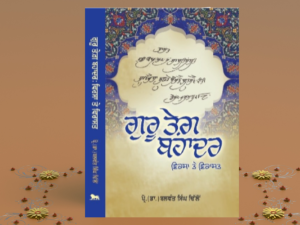Introductory Note: This study by Jaskanwar Singh, a young Sikh Historian of Leicester University, explores the role of the Sikhs during the Partition of India. He establishes that only the Sikhs fought for United India while Muslim League, Congress, Hindu Mahasabha/RSS, and the British accepted the Partition of India based on Two Nation Theory. Sikhs raised the demand for Khalistan only to counter the propaganda for Pakistan. They made maximum sacrifices for freedom of India but also suffered the most in life and property, which is a dilemma unresolved till today. Sikh leaders stood like a rock to save Punjab for India.
Jaskanwar Singh is the author of this dissertation of 44 pages submitted to University Leicester for his BA degree. It has three Chapters followed by a vast Bibliography. It narrates the story of the Sikh community fighting for their existence by opposing the creation of Pakistan during 1940-1947. Jaskanwar writes: “From the proclamation of Pakistan in 1940 to the eventual partition of Punjab, the Sikh community resisted the formation of Pakistan and the loss of their heartland to Muslim domination. The Sikhs saw the possibility of complete Muslim domination as a threat to their existence, as even under the Unionist government, Sikhs found their way of life undermined and endangered. The Sikhs responded to proposals by the League, the British and Congress with their own demands. In response to the Lahore Resolution of the Muslim League, Sikhs presented the idea of Khalistan”.
In Introduction, the author laments that the Sikhs bore the brunt of migration and their homeland, Punjab, was divided into India and Pakistan resulting in the massacre of millions of innocent Sikhs. The author gives the reason for undertaking this study: “Dr Indu Banga provides an informative piece on Sikh politics during the partition, where she explains how the Sikh leadership reacted to the potential of Muslim domination. However, the work lacks to explain the justifications behind the Sikh responses, which is what I attempt to provide in the dissertation”.
He refers to the situation where the Sikhs felt ignored: “Historiography on the partition and the transfer of power in India favours the notion that there were three actors involved, namely the British, Muslim League and Congress, and grants a few references to the Sikhs, only emphasising the situation the Sikhs found themselves in”. He clearly emphasises the role played by the Sikhs during Partition: “The Sikhs were in favour of a united India, and any form of partition was the last resort. The unity of India was more important than a Sikh state”.
Chapter 1describes the events leading to the concept of Pakistan, a Muslim State based on Two Nation Theory. The author writes: “The Lahore Resolution of 1940, was the ‘magna carta’ of Pakistan”. In the 1941 census, Muslims constituted 55% of the total population of Punjab. The Muslim League pleaded for inclusion of entire Punjab area in Pakistan. Gandhi and Nehru took its claim lightly but the Sikhs vehemently opposed and earned the wrath of Muslim League. The ruling Unionist Party in Punjab failed to checkmate the demand of Muslim league; rather it crumbled under its pressure. According to author: “Amongst the Sikh community, the Lahore Resolution ‘presented the prospects of permanent Muslim domination’ in the province of Punjab. Hence, they launched a virulent campaign against it as it would jeopardise their political aspirations, economic advantages, and cultural traditions. The prospect of a ‘Pakistan’ was seen as a threat to the very existence of the Sikh community”.
To counter Pakistan movement, the Sikhs demanded Khalistan: “Khalistan would act as a buffer state between Pakistan and India. During the All-India Sikh Conference of 1940, it was proclaimed that if the ‘Muslim League insisted upon (Pakistan), the Sikhs would demand Sikh Raj in Punjab’. In the UP Central Sikh Conference, a resolution was passed against Pakistan: “Sikhs would aspire for ‘complete swaraj’ and any attempt made to ‘divide India into communal provinces’ would be met with opposition”. However, the demand for Pakistan resurfaced in 1942 when Cripps Draft Proposal declared that the provinces had the right to secede from the centre. The ‘local option’ clause meant that if the Muslims desired, provinces with a Muslim majority could secede from the centre. This clause was seen to be the ‘first public admission of the possibility of Pakistan’.
The author gives credit to the Sikhs to counter the scheme of Pakistan: “To weaken the prospect of Pakistan, the Sikhs would again propose a separate state. The idea of Azad Punjab was floated in July 1942 at the All-India Akali Conference with river Chenab as its western boundary and having a population balance with 40% Muslim, 40% Hindu and 20% Sikh, which would mean no single community could dominate, hence the name Azad – free. The Azad Punjab scheme was a defensive strategy that had been presented as a response to the recognition Pakistan received from the British through the Cripps Proposals. Sikhs believed that the ‘creation of Azad Punjab’ would get rid of Pakistan”. However, the proposal of Azad Punjab was flawed; it needs to be understood as the Sikh attempt to cripple the prospect of Pakistan and safeguard their interests and existence.
Chapter 2 starts with a discussion of CR Formula proposed by Chakravarti Rajagopalachari. Gandhi supported it. Rajagopalachari had proposed not only the partition of India but also the potential partition of Punjab. According to author, CR Formula was used by Jinnah to build up his case for an independent Pakistan: “Jinnah insisted on a completely independent state that covered the Muslim majority provinces and had complete independence to decide on subjects of governance. Jinnah showed no signs of compromising over Pakistan. He was now openly advocating for Pakistan, claiming all six Muslim provinces. Any proposals to amend the boundaries were rejected by Jinnah”.
The Sikhs reacted strongly to the C.R. Formula and the Gandhi-Jinnah talks. Gandhi’s attempt to reach out to Jinnah and the Formula were seen as betrayals. The Formula was a breach of the 1929 Lahore pledge where Congress had promised to not do anything that affected the Sikhs without considering them first. The author expresses the fear of the Sikhs: “The Sikhs with no majority in any district would be subject to Muslim and Hindu rule, putting them ‘under perpetual slavery of the two. Gandhi and Jinnah were tyrants that wanted to ‘impose Hindu and Muslim majorities on the Sikhs’ through dividing India”.
It is unfortunate that the community contributing 40% revenue to Punjab was pushed to the wall. Sikh survival was deemed at stake, as they were not involved in any negotiations despite being the most critically affected community. The Sikhs wanted to enjoy the fruits of freedom and not live on the charity of others. However, the demand for a separate Sikh state was the last resort, that was rooted in fear of Hindu and Muslim domination. The proposals made for a Sikh state were conditional; if Pakistan seceded, and India divided, then the Sikhs would want their own state. According to author: “The Sikhs stood for the unity of India first and foremost, and wished for Hindus, Muslims and Sikhs to live together. A Sikh state was the last resort, and not a welcomed choice. Despite provocative speeches advocating for a Sikh state, it was clear from many Sikh stages that Sikhs would rather remain in a United India”.
In the Punjab assembly election of 1946, Muslim League fought on the manifesto of Pakistan. However, they failed to win the majority. The coalition of Congress, Unionist Party, and Akali Party formed the government but failed to provide stability. The Muslims in the Unionist Party supported the Muslim League and Governor’s rule was imposed. In March 1946, a Mission was sent to India to decide the fate of India. On March 22, 1946, Sikh leaders met the Mission and demanded a Sikh state –Sikhistan – as an ‘additional provincial unit’ in United India. Sikhistan was different to Azad Punjab which was proposed as a redrawing of the boundaries of Punjab to exclude Muslim majority areas, therefore creating a province where no community could dominate. Azad Punjab could not be seen as a Sikh state, however, Sikhistan would be a Sikh federation, and it would have a distinctly Sikh character. All significant Sikh Gurdwaras and shrines would be included in this area.
It was clarified that the demand for a Sikh state was not rooted in communalism but was the only guarantee for survival. On one hand the Sikhs faced Muslim hostility, which was a historical trend, and on the other, they had Hindu nationalism that attempted to ‘reabsorb them into Hinduism’. The Sikh issues remained unresolved by the Mission as they had no bargaining power due to their population nowhere in majority in any district of Punjab. The Mission ‘liquidated the position of the Sikhs’ in their homeland.
Chapter 3 describes the crisis in Punjab created by the Muslim League. Its agitations collapsed the coalition government and proved too much for Khizar Hayat Khan, who resigned as the Premier of Punjab. Muslim animosity against Sikhs was evident. Sikh police were sometimes targeted by Muslim mobs. Congress would agree to a partition as the only solution to communal violence. Master Tara Singh also included partition of Punjab in his proposals.
The Sikhs were caught in a dilemma. The Akalis would adopt various strategies to keep the Sikh population together. Sikhistan, a state between Chenab and Jamuna, was revived, to be based on ‘landed property, sacred shrines and other interests of the Sikhs. However, Mountbatten, who was deputed by the British government to decide the fate of India, made it clear that Sikhistan was not viable. The British, wishing to avoid the partition of Punjab and the bloodshed between communities, encouraged the Sikhs to consider an autonomous Sikh area within Pakistan. The Sikh community would remain intact as a fourteen percent minority in Pakistan, but in India, they would be submerged in the Hindu majority.
After prolonged parleys with Muslim League leader Jinnah, the Sikhs realized that their safety will be compromised if they join Pakistan. Unfortunately, Jinnah also provided no ‘coherent and acceptable guarantee of their safety’. His indifference towards any agreement was matched by Sikh stubbornness. Jinnah proclaimed, ‘Sikhs could go to the devil in their own way’ as they ‘demanded the partition of Punjab’. Riots targeting Sikhs increased the mistrust and fear of Muslim domination, therefore there was no understanding between the League and the Sikhs. Pakistan was not avoidable, rather it had become a reality.
According to the author: “The Mountbatten Plan of June 3, 1947, delivered the partition of India into two sovereign nations. Nehru, Jinnah and Baldev Singh accepted the plan. The fate of the Sikhs lay in the decision of the Boundary Commission. The Commission was told that ‘any partition that did not secure the integrity and solidarity of the Sikhs would be unacceptable and would create a difficult situation”. No one was satisfied with the Awards. Sikhs had been unable to secure any substantial ‘guarantee of their security’ despite the violence in the province proving that Sikhs could not expect any security under Muslim domination.
Jaskanwar Singh concludes that the Sikhs were losers on all fronts: “The hopes for Sikhistan were buried by the Awards, and the Sikhs lost the land they had historical and cultural roots in, and the land they saved from many foreign invasions in the past. Their attempts at preventing Pakistan had failed, and their final fight to retain as much of Punjab had resulted in an unsatisfactory division that split their community. The largest mass migration of humans followed the partition, that saw millions of people killed or displaced”.
Conclusions
- It is evident from the above discussion that the idea of a Sikh State (Khalistan) was a means of opposing the idea of Pakistan through the repeated use of the phrase ‘if Pakistan is to be conceded’. The Sikhs did not want their own state and understood the impracticality of their demand.
- The toughest resistance to the Cripps proposal came from the Sikhs, who felt their cause had ‘been lamentably betrayed’. The Congress, the Muslim League, and the British were responsible for partition of India. Only the Sikhs were fighting for United India against all odds.
- The Sikhs had managed to save a significant portion of Punjab for India by opting to join India unconditionally.
- The proposals of an Azad Punjab province, Khalistan or Sikhistan, and the autonomous Sikh area within Pakistan and the eventual formation of an East Punjab all prove the efforts made by the Sikhs to secure political safeguards as the British Raj came to an end.
* A dissertation submitted to University of Leicester by Jaskanwar Singh BA, May 2022.





